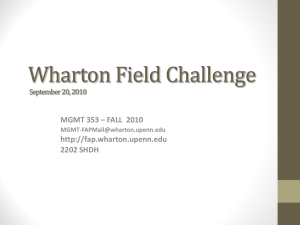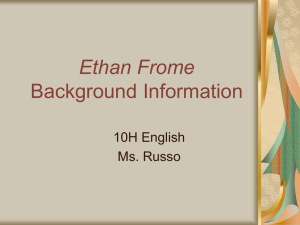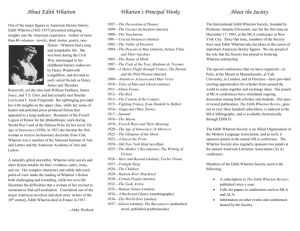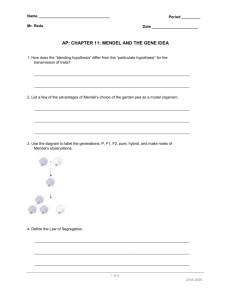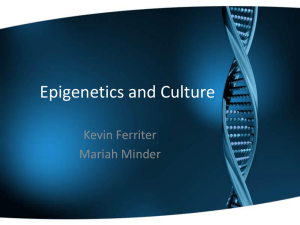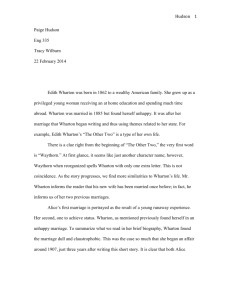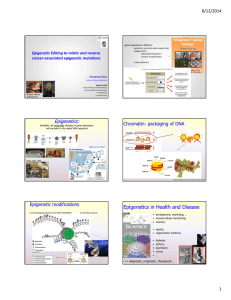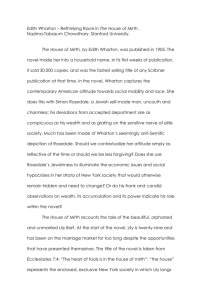On the Panel: Reproductions: Eugenics and Genetics Program
advertisement
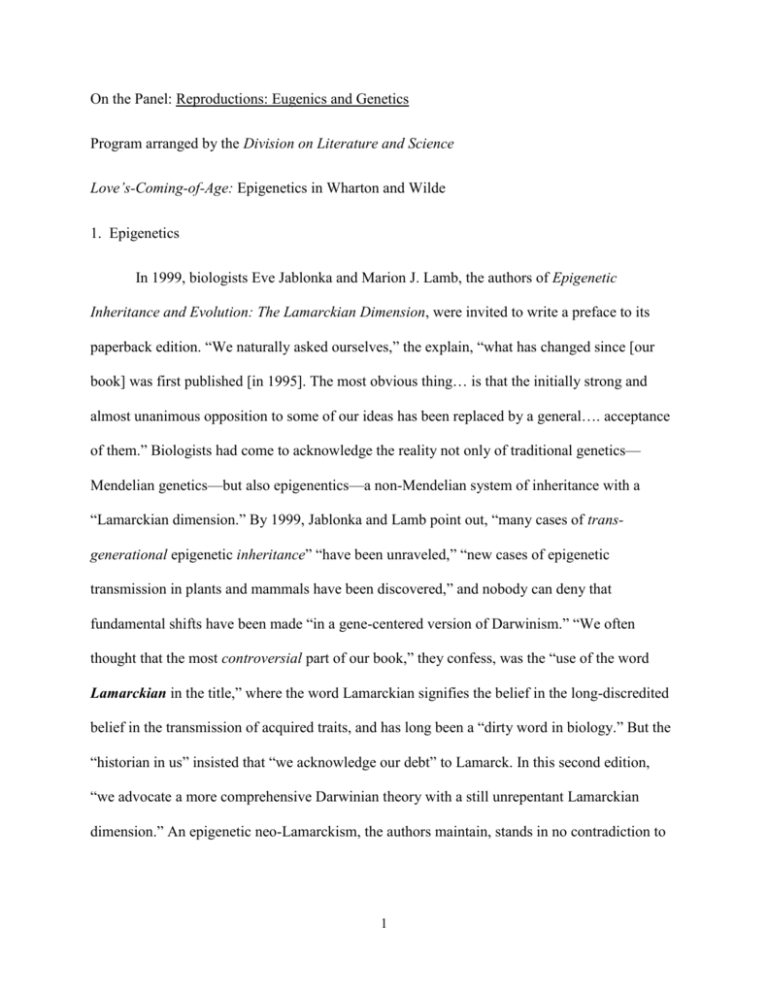
On the Panel: Reproductions: Eugenics and Genetics Program arranged by the Division on Literature and Science Love’s-Coming-of-Age: Epigenetics in Wharton and Wilde 1. Epigenetics In 1999, biologists Eve Jablonka and Marion J. Lamb, the authors of Epigenetic Inheritance and Evolution: The Lamarckian Dimension, were invited to write a preface to its paperback edition. “We naturally asked ourselves,” the explain, “what has changed since [our book] was first published [in 1995]. The most obvious thing… is that the initially strong and almost unanimous opposition to some of our ideas has been replaced by a general…. acceptance of them.” Biologists had come to acknowledge the reality not only of traditional genetics— Mendelian genetics—but also epigenentics—a non-Mendelian system of inheritance with a “Lamarckian dimension.” By 1999, Jablonka and Lamb point out, “many cases of transgenerational epigenetic inheritance” “have been unraveled,” “new cases of epigenetic transmission in plants and mammals have been discovered,” and nobody can deny that fundamental shifts have been made “in a gene-centered version of Darwinism.” “We often thought that the most controversial part of our book,” they confess, was the “use of the word Lamarckian in the title,” where the word Lamarckian signifies the belief in the long-discredited belief in the transmission of acquired traits, and has long been a “dirty word in biology.” But the “historian in us” insisted that “we acknowledge our debt” to Lamarck. In this second edition, “we advocate a more comprehensive Darwinian theory with a still unrepentant Lamarckian dimension.” An epigenetic neo-Lamarckism, the authors maintain, stands in no contradiction to 1 classical Darwinism; selection is necessary for adaptation, and epigenetic systems merely provide “additional heritable variations on which selection can act.” It’s 2011, over a decade since the printing of the paperback with its unrepentant preface, and the field of epigenetics has flourished and gained ground. (One scientist has even introduced the term “dual inheritance” to cover both genetic and epigenetic systems.) How does epigenetics differ from traditional genetics? Traditional Mendelian genetics, the science with which most of us are the most familiar, assumes that the biological legacy we acquire from our parents and grandparents is a result of the individual genes they pass on to us unaltered, barring the rare changes in gene sequences called mutations. This is a genetics based on cell lineages and clonal inheritance; environmental influences do not alter the genotype and there is no Lamarckian mechanism—no inheritance of acquired characters. Epigenetics, on the other hand, endorses the transmission of environmentally-acquired traits. Epigenetics assumes that some changes in genes do not involve mutations—changes in the DNA sequence—but rather “changes to the chemical adornments that attach to the naked gene.” These alter what a gene does, sometimes disabling its expression, sometimes causing it to be overactive. In epigenetic systems, the environment of a cell is crucial in determining its properties or fate: a hormone or morphogen, for instance, can affect the genome. An epigenetic state of a gene, moreover, can be established not only in vitro but also in vivo. It’s now welldocumented that something an organism experiences early in life, especially, alters the DNA she passes on to offspring. The attentive maternal grooming of a baby mouse, for example, effects changes in a chemical in its brain that regulates stress hormones. But the mouse deprived of such grooming overproduces stress hormones, which modify specific genomic regions. The stressedout mouse then transmits the effects of its experience, in molecular memory, to offspring.1 2 My talk today is taken from a larger project about telegony, a XX of biological inheritance encompassed by epigenetic theory. More specifically, my talk addresses the controversy surrounding telegony in the early 1900s, and the literary productions the battle shaped. Telegony is the ancient hypothesis—long accepted in animal husbandry—that the sire first mated to a female will have an influence upon that female’s later offspring by another male. Thus the phenomenon is sometimes called the “sire effect,” and the term telegony is Greek for “offspring at a distance.” As the renowned nineteenth-century naturalist Louise Agassiz put it, “later pregnancies…. Do not efface that first impression.” A female acquires the traits of her male mate as a result of the mating process; if and when she reproduces, no matter with whom, she passes them on. Descriptions of how she acquired his traits vary: either her reproductive organs are directly modified by the seminal fluids of a mate; or intercourse affects her entire system; or perhaps her fetus “infects” her, so to speak, with paternal traits by way of the blood that circulates through both fetus and mother. A model of inheritance with a Lamarckian dimension, telegony comes under fire at the turn of the century when what the novelist Edith Wharton called “the war over the transmission of acquired traits” was engaged and Lamarckian assumptions were aggressively challenged. During the decades that saw August Weismann’s discovery of the germ-plasm, the rediscovery of Mendel, the rise of genetics, and the growth of eugenics, the pro-Lamarckian science of telegony was debunked. My paper originated in an effort to recover this neglected historical model of heredity by demonstrating its presence and potency in short stories by Edith Wharton and a pornographic novel attributed to Oscar Wilde. But I quickly discovered that research biologists in our own generation had already recovered telegony, not as an artifact of history but an empirical possibility. New research reveals several mechanisms that make telegony plausible; evidence now shows that “foetal cells 3 and DNA” can be found circulating in maternal blood; spermatozoa are “able to penetrate the somatic tissues of the female and may deliver RNA to cells where it may have regulatory and genetic effects”; and “sperm-mediated reverse gene transfer (SMRGT) can lead to the generation and propagation of new genetic information” by mature spermatozoa, independent of the information carried in the genome.” Thus in a 2010 edition of the research journal Reproduction in Domestic Animals the author of an article on the “non-Mendelian inheritance of epigenetic changes” concludes that the “time has come when further progress in our understanding of heredity requires that we reconsider the case of telegony.” Maybe I’ve lost your attention as you now consider the case of telegony in your own life (have you acquired the traits of your first sexual partner?), or ponder other epigenetic changes (do you find the MLA stressful because, like the much-sited mice, your early grooming was neglected?). But let me turn to accounts of telegony at the end of the nineteenth-century, not the least because they seem prescient about discoveries in our own. Some turn-of-the-century scientists and novelists were ahead of us in the belief that the individual exists in recursive rapport with her environment, while their theory that experience affects the genome has been confirmed. 2. telegony In 1899, zoologist James Cossar Ewart wrote the in journal Nature that “no problem [today] claims wider attention than what is generally known as telegony.” On one side, authorities like Agassiz, Charles Darwin, Herbert Spencer and Ernst Haeckel endorsed telegony and its Lamarckian paradigm. Darwin cited numerous cases of telegonic transmissions in pigs, dogs, sheep—and horses like Lord Morton’s notorious mare. (First mated to a quagga, Lord Morton’s chestnut mare was put to a black Arabian stallion years later; the offspring of the 4 stallion and mare bore the distinct stripes of the quagga, [an animal by then extinct]). But, on the opposing side, the cytologist August Weismann claimed that his discovery of the germ plasm disproved the possibility of any Lamarckian operation, including telegony, since hereditary material fixed in the germ plasm was unaffected by external influences. The zoologist Ewart hoped to decide the battle. Determined to replicate the case of the mare and the Quagga, Ewart mated horses and zebras—since, sadly, there were no more quaggas—on his farm in Scotland. The findings of the so-called Penycruik Experiments did not support telegony. Ewart concluded, however, that the science was still too inconclusive to rule it out. The results of experiments on telegony mattered not only to zoologists but also, of course, to anyone who’s considered the “problem” it posed human beings. For while breeders and farmers had recorded cases of telegony for centuries, it was “just the same in the human species,” as French psychologist Theodule Ribot put it, that the “children of the second bed, resemble the first husband, long since dead.” For Darwin, telegony explains not only the likeness between a re-married widow’s new children and her long-dead spouse, but also “what we all know from observation: how wives grow like their husbands.” Although he cautions that it’s “impossible to eliminate the effects of imitation, diet, habits of life, etc.” Darwin’s own provisional theory of heredity, called pangenesis, was telegonic; in it, the body of the female absorbs the hereditary characteristics of the male through the material in his seminal gemmules. (Here, the “one flesh” doctrine of marriage is a fact of life.) But telegony made Herbert Spencer anxious about the implications of these human fusions in modernity, specifically, in the context of modern divorce. For if the widow “carriers within her the flesh of her former husband,” so must the divorcee. As divorce and re-marriage skyrocketed in the 1890s, Herbert Spencer argued that the re-marrying woman threatened civilization itself by undermining monogamy. A divorced 5 woman was not practicing serial monogamy but, because of telegony, only “primitive polyandry.” For the dramatist August Strindberg, the scandal of telegony was not that it entailed polyandry or promiscuity but that it was queer. In his diaries, Strindberg confesses his fear that his lovers carry off parts of himself, against his volition, into the beds of strangers. “Through her,” he frets, “I am entering into forbidden relationships with men and other woman… this torments me, for I have always had a horror of intimacy with my own sex.” In his drama To Damascus, a husband turns the table on the man for whom his wife has left him by saying: “Through the women you stole from me, I will lead you like a Bullock… I lie in your bed! I am in your blood your lungs your brain!” But even as Strindberg and Spencer feared the implications of telegony, whether for themselves or for society, the activist Edward Carpenter celebrated telegonic transmission for its utopian potential. Agreeing with Charles Darwin that through telegony “wives grow like their husbands,” Carpenter writes that it is not just wives but rather “all lovers” who, “after some years come to resemble each other”—in features, facial expression, bodily carriage, tone of voice and “even handwriting.” A glance back at the “love affairs” of the Protozoa, he writes, explains it all. Even “when two cells which are about to unite approach each other,” the chromatin from one cell dispels half its cargo and the other does the same. So, too, even in the approach of humans toward sexual union there are “radiations and reactions… fusions and exchange,” as one” “internal economy” “melt[s] and is removed.” In telegony, “Spermatozoa pass through the tissues and affect the body of the female”—but “the male,” adds Carpenter, also “absorbs minutest cells from her.” Carpenter agreed with John Addington Symonds, who wrote in their personal correspondence about sex between men that there is “no doubt that the absorption of 6 semen implies a real modification of the physique of the person who absorbs it…& that this constitutes an important basis for subsequent conditions, both spiritual & corporeal.” In Darwinian telegony, wives “grow like their husbands,” but for Carpenter, Symonds and Strindberg, the biological effects of physiological passion—Carpenter calls it “sex-love,” an “interchange of vital and ethereal elements” always occurs, “so that it might be said there is a kind of generation taking place within each of the persons concerned.” Thus in the works Love’s-Coming-of-Age (1897?) and the later Drama of Love and Death (1912), Carpenter sets out to “indicate the inner laws which, rather than the outer, guide Love,” and to correct the “tendency of medical and other authorities,” to “overlook… the important physical actions and reactions and even corporeal modifications” which may “ensue upon sexual intercourse between two people.” These authorities, he opines, too often in the service of the state, focus only on the “more specialized generation which consists in the propagation of the race.” They suppress the fact that when love finally comes of age, when it matures into sex-love, it “takes the form before all else of a desire for union, and only in a lesser degree” in a “desire for race-perpetuation.” “The idea… that the great and primal object of union should be sought in the next generation,” Carpenter concludes, “has something unsatisfactory about it. Why not in this generation?” 3. sex-love in Wharton and Wilde When Edith Wharton draws our attention to cases of telegony in two stories about marital relations, “The Other Two” and “His Father’s Son,” she takes up the gothic visions of Spencer and Strindberg but nods in Carpenter’s direction. I’ve argued elsewhere that in “The Other Two,” a bridegroom named Mr. Waythorn comes to realize that when he sleeps with his twice-divorced, yet miraculously “fresh” bride Alice, he’s sleeping with the other two husbands, too. (The text 7 playfully indicates that she carries them within her, and the ex-husbands repeatedly “cross the threshold” of this blushing bridegroom and “squeeze through” his “nuptial portals.”) But if Waythorn initially finds his situation “beastly” and the men “obtrusive,” they eventually occupy his domestic interior and dwell in what he calls the “inmost parts” of himself. The tale ends on a dramatic climax in which Alice interrupts her husband and her exes while, suggestively, they are in the middle of enjoying cigars; stripping off her gloves and boa, she rings for tea, and we leave them to what looks like a very cozy and even very sexy group marriage in which it is impossible to trace or separate “radiations and reactions” “fusions and exchange.” Wharton takes up telegony more directly, and more inventively, in “His Father’s Son,” a story that arguably alludes to the novel Teleny: A Physiological Romance, a pornographic text some attribute to members of Oscar Wilde’s social circle, and some to Oscar Wilde himself. In “His Father’s Son,” the dull sex life of the dull Mr. and Mrs. Mason Grew gets interesting when they attend a concert and hear a foreign musician, Fortune Dolbrowski, play Chopin. Back in their hotel room—still wrapped in a “transfiguring mist of sound”—they go to bed, but not before Mrs. Mason expresses a desire to write Dolbrowski to tell him how he has made her feel, and Mr. Mason eagerly composes the letter she copies and sends. Dolbrowski writes back to Mrs. Mason, enclosing a portrait of himself that the couple hangs on the wall above the bed. This correspondence proceeds for months in just this fashion—but with Mr. Grew XX to Dolbrowski as if he were Mrs. Grew—and soon enough, a beautiful son is born to the Masons who seems to be the child of Fortune Dolbrowski. Oscar Wilde’s Teleny, written several years before Wharton’s story, shares similar traits. Here, our narrator, named des Grieux, and the exotic musician Renne Teleny, share an exchange “of thoughts of feelings of sensations,” at first acoustically, then telepathically, and then as 8 lovers. When later the musician Teleny makes love to a Countess, he fantasizes that she is des Grieux, while des Grieux experiences their liaison at a distance, as if he is in on it as well, from a distance. Nine months later, the Countess gives birth to a son who resembles des Grieux. Writing about Teleny in her work on literature, technology, and magical thinking at the century’s end, Pamela Thurschwell suggests that in Teleny, telepathy seems to function as “trope and ground for male homosexual sexuality based on narcissism and non-differentiation.” But in the medical and literary histories I’ve been tracing, the males’ telepathy is inevitably queer, not in the Freudian context of narcissism but in the biological context of telegonic transmission. Telegony and telepathy cohere in Teleny: a Physiological Romance, as forms of telecommunication that entail affective responses between partners, materially transfiguring each person and leaving heritable epigenetic marks. At first blush, women seem to serve in these narratives merely as copyists or mediums between men: same-sex desire gets expressed through the bodies of women who own identity and agency are effaced, even as they deliver a child who inherits its two fathers’ traits. But if this is true in the text attributed to Wilde, close readings of Wharton’s “His Father’s Son” and “The Other Two” reveal female characters as involved as men in the subversion of erotic norms. Following Wharton scholar Richard Kaye, we can read Wharton’s writing in the context of her life in Paris and within a specific male coterie. Her group of intimate friends included not only Henry James but also Wharton’s bi-sexual lover, Morton Fullerton, who was himself a member of Wilde’s circle. Read more closely, the queer disruptions or reinventions of erotic properties or reproductive norms do not appear to go unnoticed nor are they merely tolerated by female protagonists like Alice Waythorn and Mrs. Mason. Instead, the women value and manage them to the benefit of their own illicit and amorous impulses. In Wharton’s letters to and poetry about 9 Morton Fullerton, she suggests that precisely what frightens Strindberg about his partner—that she inevitably brings others into his bed or carries parts of him off to strangers—Wharton marks as the occasion for an ecstatic self XX her language associates with the sublime. When she fell in love with Fullerton in her late middle age, Wharton fell into sex-love. In poems like “Terminus,” written for Fuller and about a liaison in a train station hotel—a liaison that is, oxymoronically, interminable—the speaker expresses that the “great and primal object of union” is her own vital origination, not the next generation’s. The speaker suggests that she is sleeping not only with her lover, but all the lovers he has had and even all the former occupants of the room, “faces innumerous and vague of the endless travelling automata,” and the “shadow-mouths melted to one.” Both Wharton and Wilde wrote passionately about the way the intimate material environment—especially the decoration of the houses—affects the body and mind; in their texts, the aesthetic impressions yield biological effects, producing epigenetic traits. Their writings about telegony similarly reveal that they see love affairs and marriages as environments, ecologies, biomes in which we adapt and re-adapt to, and live in recursive rapport with, the bodies and minds, habits and tastes of our partners. Writing recently about New Women writers in Great Britain, like Mana Caird, Regina Gagnier persuasively argues that what’s crucial about their fiction rests in its “psychological assessment of the scope and limits of autonomy and interdependence, solubility and separation within relationship, much more than polemics about marriage or art.” I’d add only that not only their psychological but also their biological assessment of the limits and scope of marriage marks the work of New Women like Edith Wharton. Critics have recently characterized Wharton’s fiction as compromised by its complicity with the politics and policies of early-twentieth century eugenics and the rise of genetic science. 10 But her literary project is, I argue, not about genes, genetics, and the genome but experience, epigenetics, and the epigenome, and how they shape our encounters with husbands and lovers as well as houses and rooms. 11
